How 11 Texas cities made housing unaffordable — and what's being done to fix it
Sign up for The Brief, The Texas Tribune’s daily newsletter that keeps readers up to speed on the most essential Texas news.
This is the second part of a series of stories on housing affordability in Texas. You can read the first part here. Have you been affected by Texas’ housing affordability crisis? We want to hear from you.
Housing costs in Texas are at some of their highest levels in decades. One reason why: The state doesn’t have enough homes.
The state needs to build more homes — about 320,000 more, by one estimate — if it wants to put a dent in that shortage and put housing costs in check, housing advocates, real estate experts and homebuilders say.
But rules in its major cities make that exceedingly difficult, according to a Texas Tribune analysis.
Developers can build standalone single-family homes — long the American ideal of homeownership — nearly anywhere in Texas cities where housing is allowed. But cities largely forbid other kinds of housing, like townhomes, duplexes and small apartment buildings, from being built in those same areas, the Tribune’s analysis found. They don’t leave nearly as much room elsewhere for those kinds of homes or larger apartment buildings, either.
Those restraints limit how many homes can ultimately be built, leaving Texans to compete for a limited supply of options and resulting in higher home prices and rents.
City and state policymakers are beginning to realize that, if they want to avoid the problems of other large states like New York and California, the rules need to change.
“The thing that Texas can learn from the states that have even worse housing affordability crises is that you can’t wait,” said Vicki Been, director of New York University’s Furman Center for Real Estate and Urban Policy. “You’re creating a deficit day by day and that deficit is growing.”
How zoning shapes Texas cities
Zoning rules guide cities’ development decisions, including where grocery stores, shops and restaurants can go; whether factories can be built near neighborhoods; and whether apartments can be built on top of shops and restaurants. They dictate how much land homes must sit on and how many homes can be built on a given lot.
In most Texas cities, zoning regulations require homebuilders to provide a certain amount of parking, sometimes compelling them to build parking spaces where they could’ve built more homes. Cities like Dallas and Austin limit how tall apartment buildings can rise depending on how close they are to existing single-family homes.
In addition, cities make it easier to build detached single-family homes than other kinds of housing. If a builder wants to develop other types of homes in a place where doing so isn’t already allowed, they must first obtain city approval — an often lengthy and sometimes contentious process.
All of those rules add up and ultimately increase the final cost of a home, whether it’s for sale or rent.
“Zoning regulations restrict supply,” said Been, who previously served as New York City’s Commissioner of Housing Preservation and Development. “If supply isn’t meeting demand, then prices will go up. It’s pretty straightforward.”
Standalone single-family homes can be built on more than 98% of land that allows some type of residential development, according to a Tribune analysis of zoning codes and land-use patterns in 11 of the state’s largest cities.
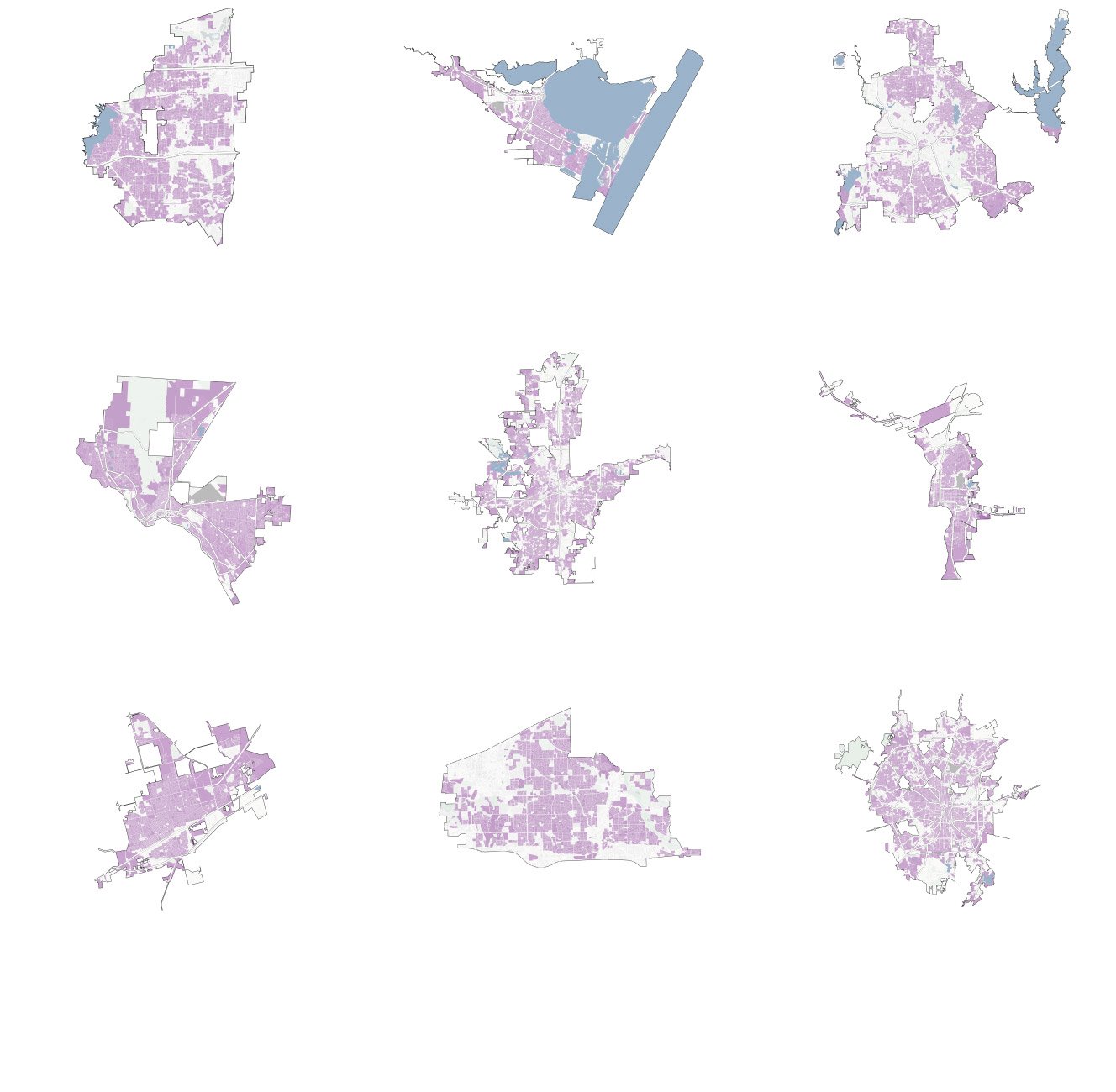
Corpus Christi
Dallas
Arlington
99%
96%
100% of land that allows residential units
El Paso
Fort Worth
Laredo
100%
100%
100%
Odessa
Plano
San Antonio
86%
86%
100%
Note: Maps not shown at scale. Planned development districts are not included in the analysis. Data is current as of October 2024.
Source: City planning departments

Arlington
Corpus Christi
Dallas
99%
96%
100% of land that allows
residential units
El Paso
Fort Worth
Laredo
100%
100%
100%
Odessa
Plano
San Antonio
86%
86%
100%
Note: Maps not shown at scale. Planned development districts are not included in the analysis. Data is current as of October 2024.
Source: City planning departments
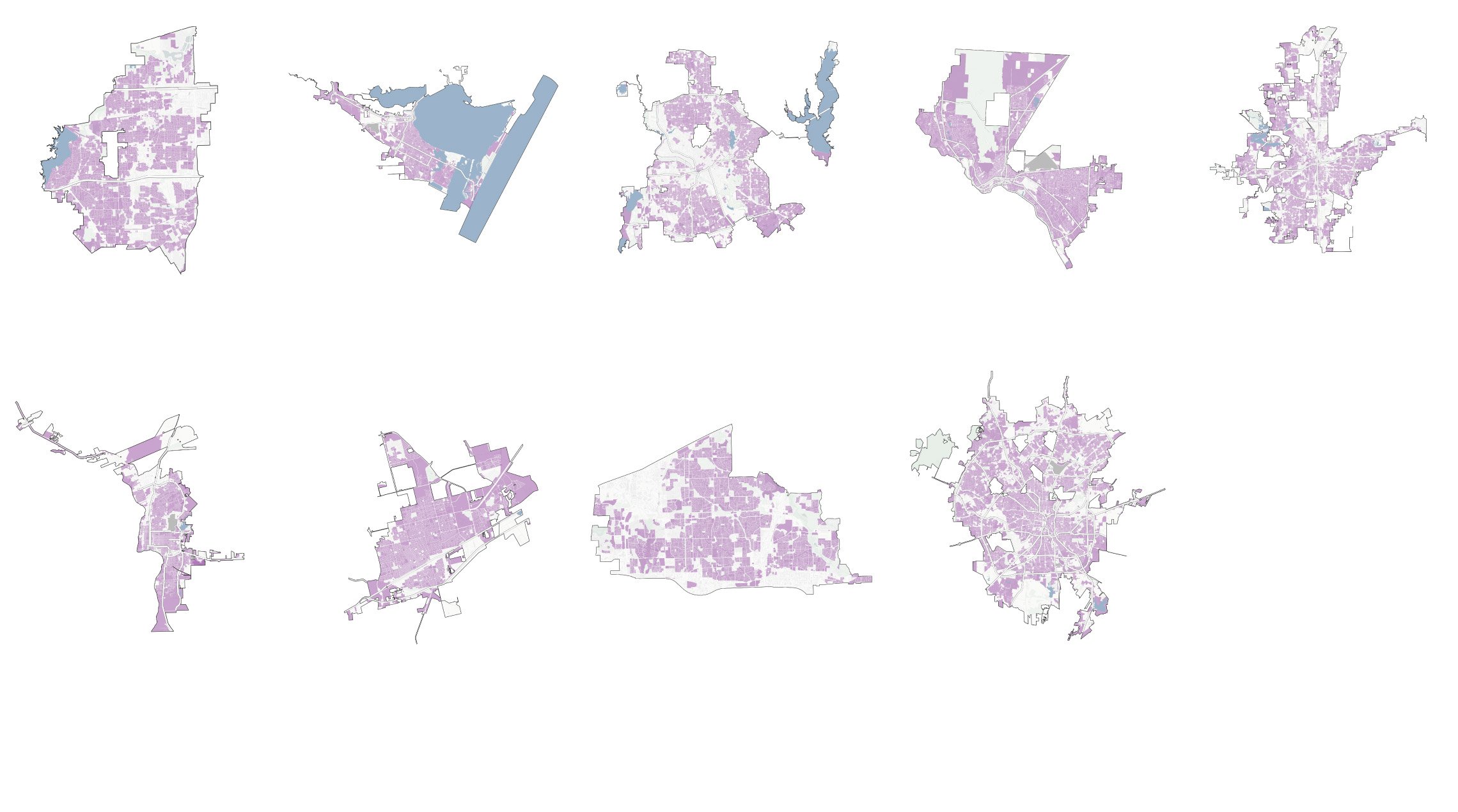
Arlington
Corpus Christi
Dallas
El Paso
Fort Worth
99%
96%
100%
100%
100% of land that allows residential units
Laredo
Odessa
Plano
San Antonio
100%
86%
86%
100%
Note: Maps not shown at scale. Planned development districts are not included in the analysis. Data is current as of October 2024.
Source: City planning departments
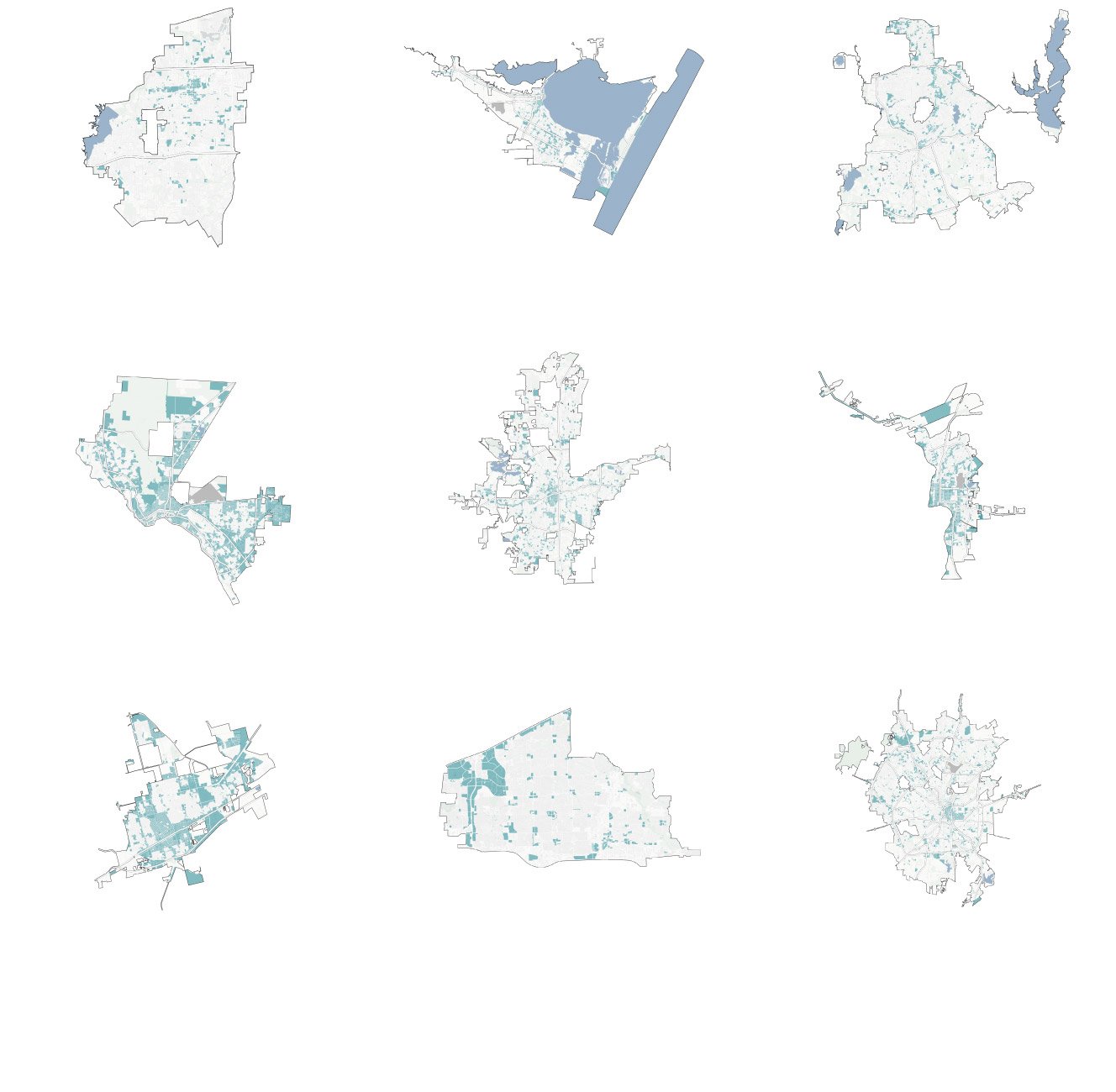
Corpus Christi
Dallas
Arlington
23%
17%
11% of land that allows residential units
El Paso
Fort Worth
Laredo
56%
22%
50%
Odessa
Plano
San Antonio
47%
25%
21%
Note: Maps not shown at scale. Planned development districts are not included in the analysis. Data is current as of October 2024.
Source: City planning departments
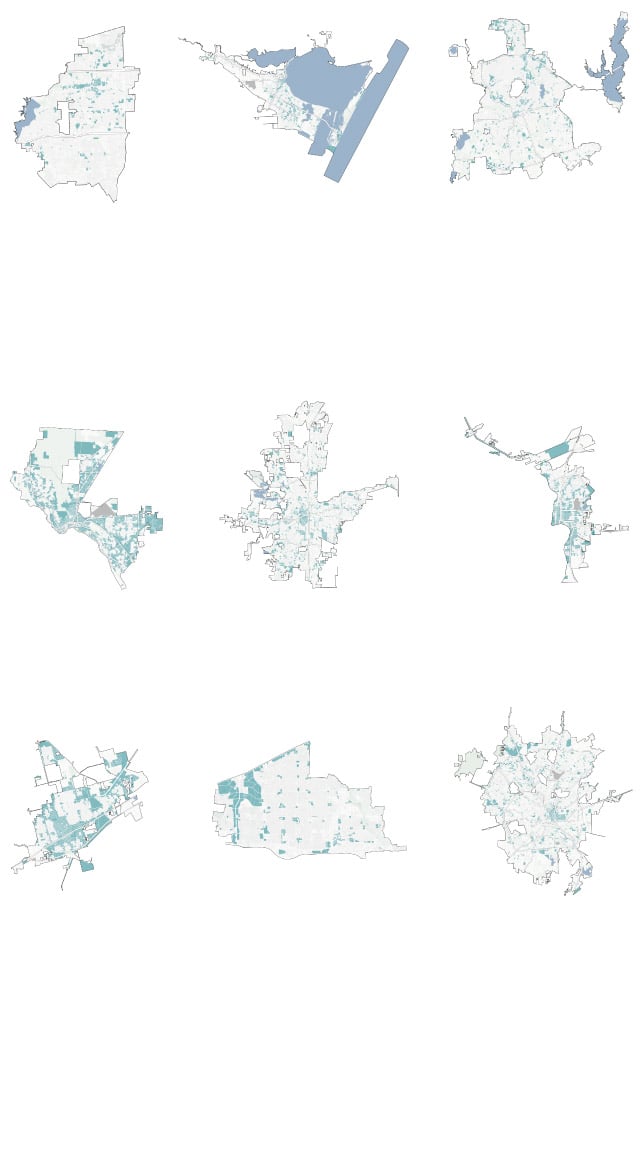
Arlington
Corpus Christi
Dallas
23%
17%
11% of land that allows
residential units
El Paso
Fort Worth
Laredo
56%
22%
50%
Odessa
Plano
San Antonio
47%
25%
21%
Note: Maps not shown at scale. Planned development districts are not included in the analysis. Data is current as of October 2024.
Source: City planning departments
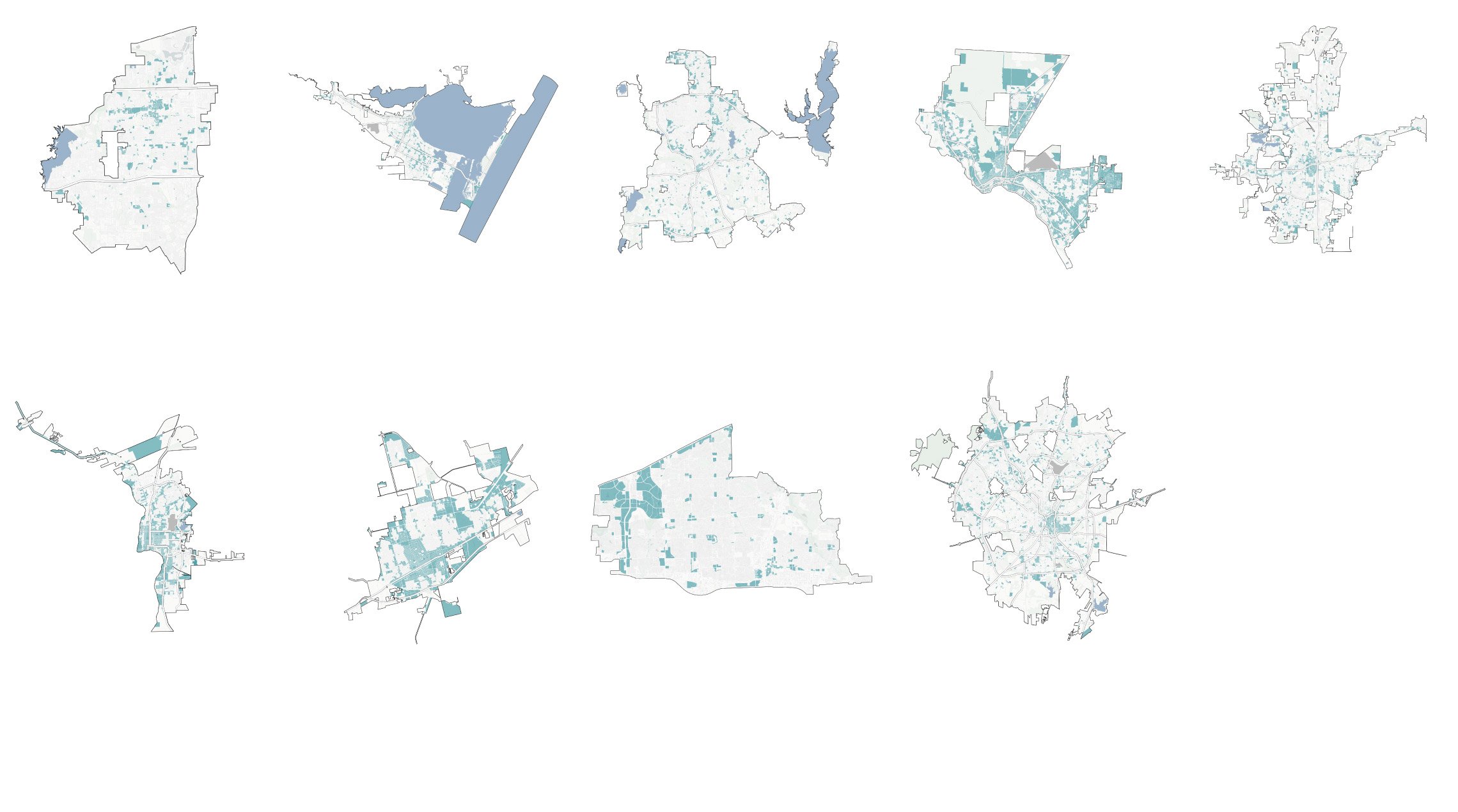
Arlington
Corpus Christi
Dallas
El Paso
Fort Worth
23%
17%
56%
22%
11% of land that allows residential units
Laredo
Odessa
Plano
San Antonio
50%
47%
25%
21%
Note: Maps not shown at scale. Planned development districts are not included in the analysis. Data is current as of October 2024.
Source: City planning departments
Housing types other than detached single-family homes can only be built on less than two-fifths of that land, the analysis found. That leaves Texas cities with fewer places to build denser kinds of housing and add enough homes to meet demand, driving up overall housing costs.
Getting a precise picture of what kinds of housing city rules allow and where can sometimes be tricky.
Take Dallas, the state’s third-largest city and the nexus of its largest metropolitan region. City officials in September approved a new comprehensive land-use plan that aims to encourage more kinds of housing in what have long been single-family neighborhoods.

5 miles
Dallas
SINGLE-FAMILY DETACHED HOUSING
OTHER KINDS OF HOUSING
LAKE RAY
HUBBARD
LAKE RAY
HUBBARD
Dallas Love Field Airport
Dallas Love Field Airport
45
45
96% of land that allows residential units
17% of land that allows residential units
Note: The Tribune’s analysis does not include planned development and conservation districts. Those areas account for about 21% of the land where the city can regulate zoning.
Source: Dallas Planning & Development

Dallas
SINGLE-FAMILY DETACHED HOUSING
LAKE RAY
HUBBARD
Dallas Love Field Airport
45
5 miles
96% of land that allows residential units
OTHER KINDS OF HOUSING
LAKE RAY
HUBBARD
Dallas Love Field Airport
45
17% of land that allows residential units
Note: The Tribune’s analysis does not include planned development and conservation districts. Those areas account for about 21% of the land where the city can regulate zoning.
Source: Dallas Planning & Development

Dallas
5 miles
SINGLE-FAMILY DETACHED HOUSING
OTHER KINDS OF HOUSING
LAKE RAY
HUBBARD
LAKE RAY
HUBBARD
Dallas Love Field Airport
Dallas Love Field Airport
35E
45
35E
45
96% of land that allows residential units
17% of land that allows residential units
Note: The Tribune’s analysis does not include planned development and conservation districts. Those areas account for about 21% of the land where the city can regulate zoning.
Source: Dallas Planning & Development
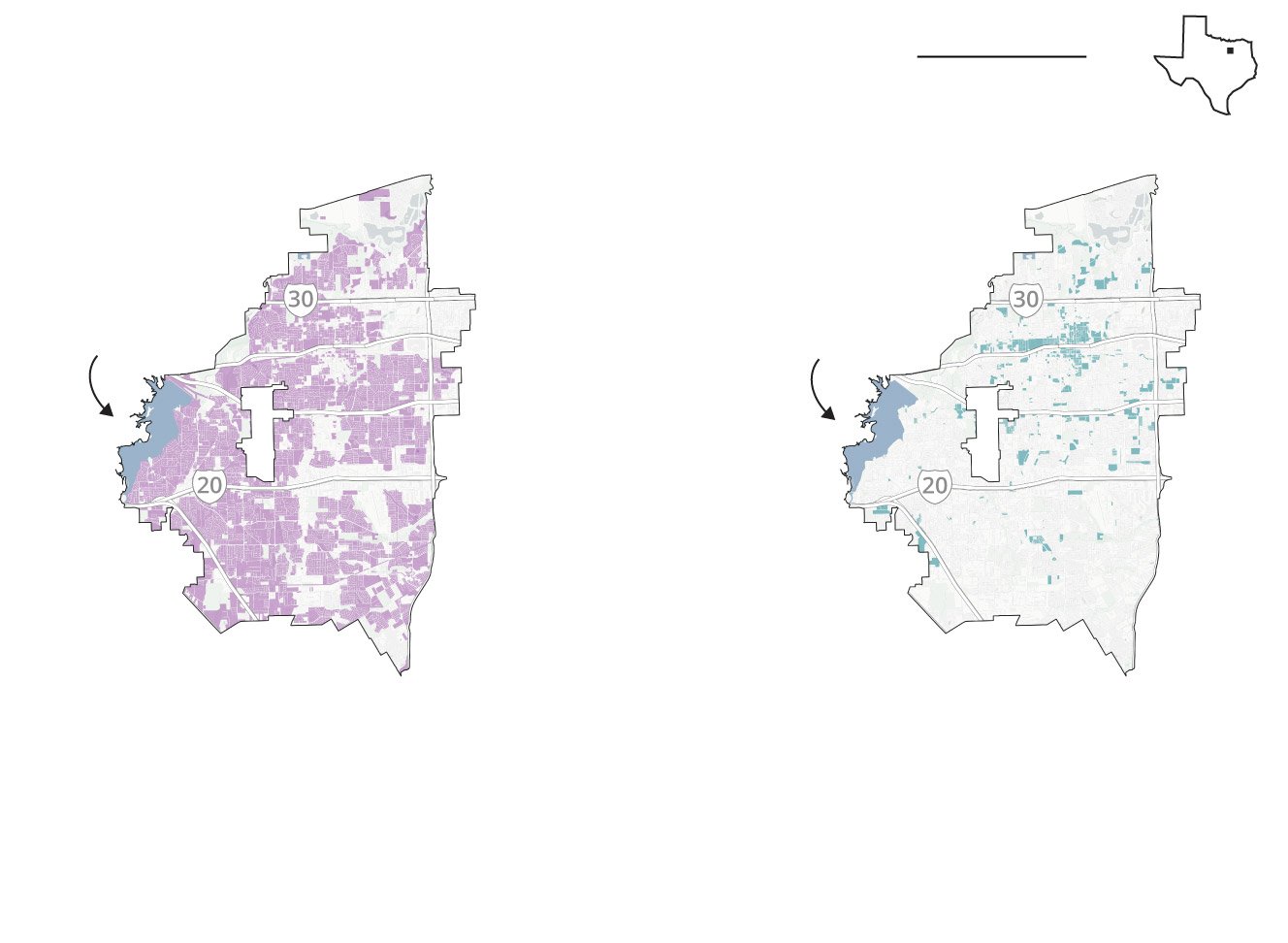
3 miles
Arlington
SINGLE-FAMILY DETACHED HOUSING
OTHER KINDS OF HOUSING
LAKE
ARLINGTON
LAKE
ARLINGTON
100% of land that allows residential units
11% of land that allows residential units
Note: The Tribune’s analysis does not include planned development. Those areas account for about 15% of the land where the city can regulate zoning.
Source: Arlington Planning & Development Services
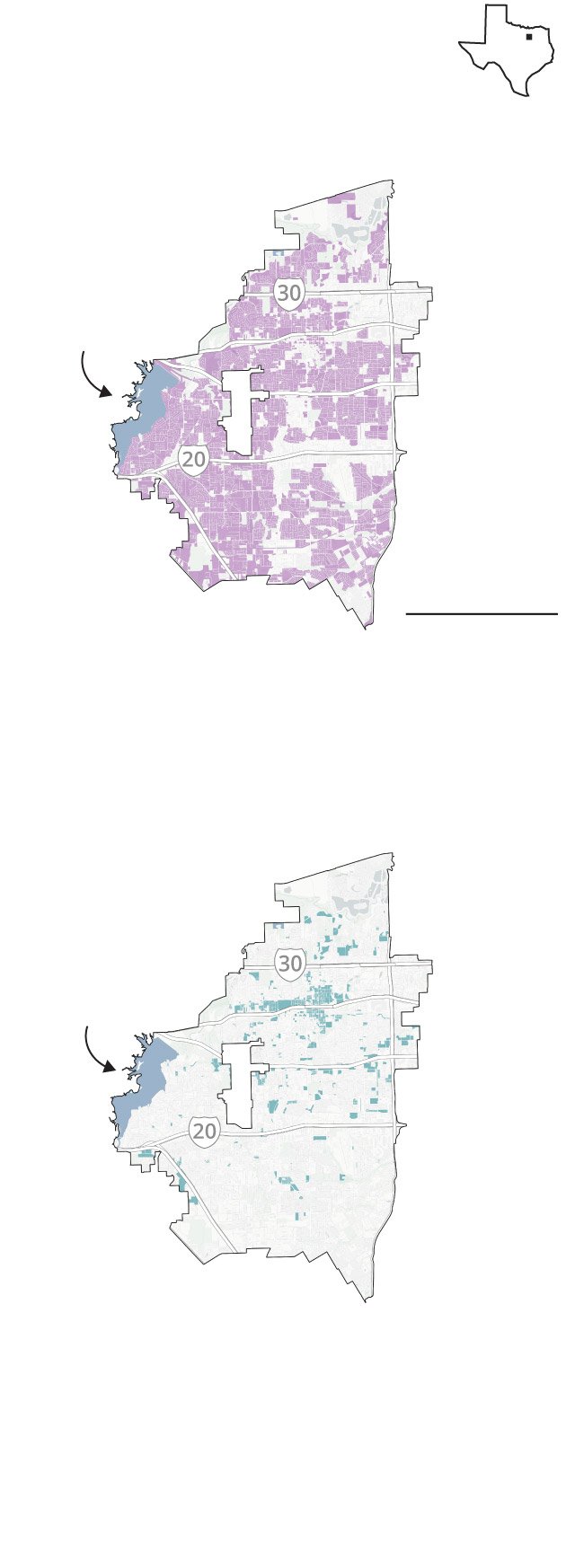
Arlington
SINGLE-FAMILY DETACHED HOUSING
LAKE
ARLINGTON
3 miles
100% of land that allows residential units
OTHER KINDS OF HOUSING
LAKE
ARLINGTON
11% of land that allows residential units
Note: The Tribune’s analysis does not include planned development. Those areas account for about 15% of the land where the city can regulate zoning.
Source: Arlington Planning & Development Services

3 miles
Arlington
SINGLE-FAMILY DETACHED HOUSING
OTHER KINDS OF HOUSING
LAKE
ARLINGTON
LAKE
ARLINGTON
100% of land that allows residential units
11% of land that allows residential units
Note: The Tribune’s analysis does not include planned development. Those areas account for about 15% of the land where the city can regulate zoning.
Source: Arlington Planning & Development Services
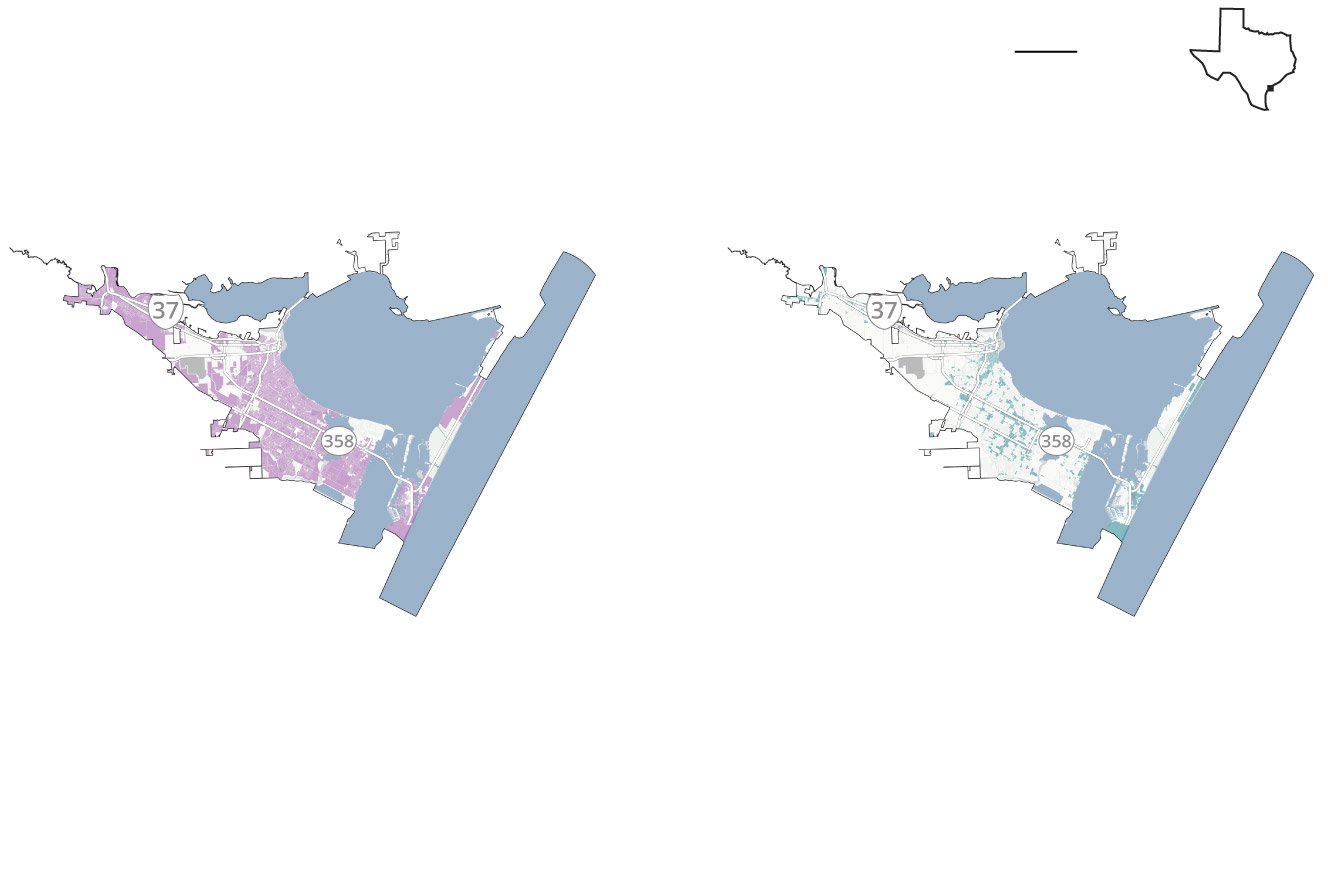
5 miles
Corpus Christi
SINGLE-FAMILY DETACHED HOUSING
OTHER KINDS OF HOUSING
CORPUS CHRISTI
BAY
CORPUS CHRISTI
BAY
99% of land that allows residential units
23% of land that allows residential units
Note: The Tribune’s analysis does not include planned unit development districts. Those areas account for about 1% of the land where the city can regulate zoning.
Source: Corpus Christi Planning Department
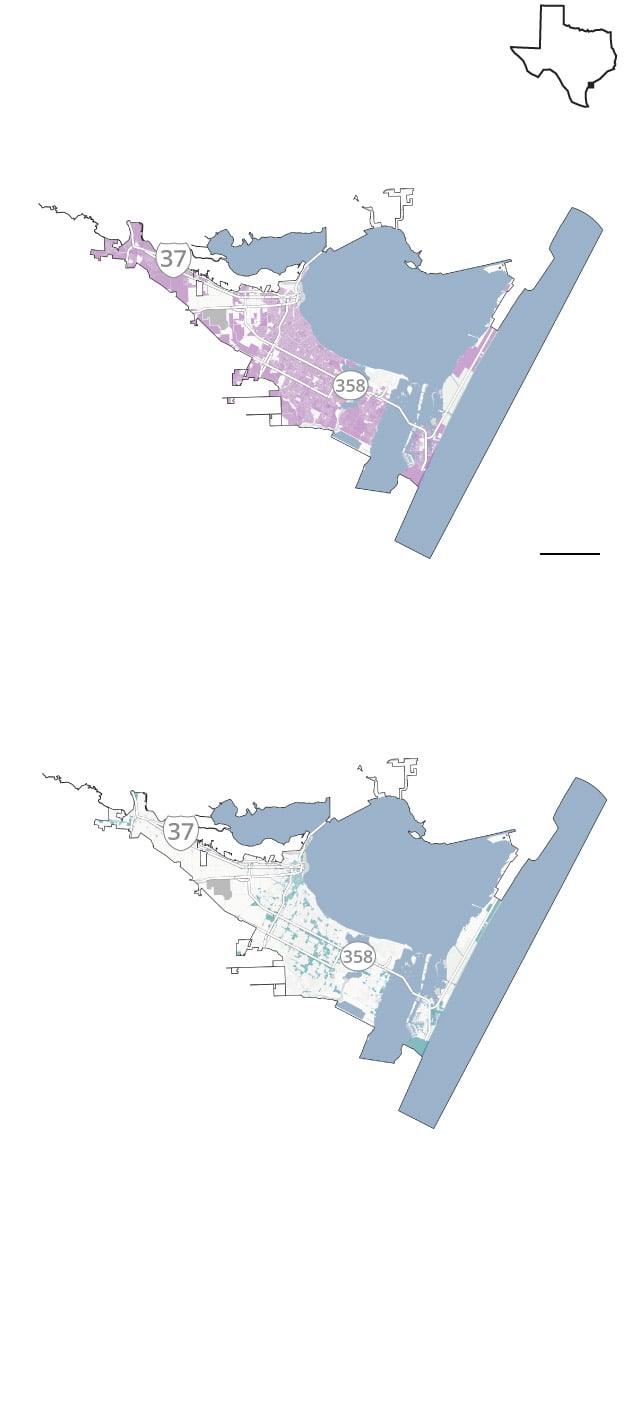
Corpus Christi
SINGLE-FAMILY DETACHED HOUSING
CORPUS CHRISTI
BAY
5 miles
99% of land that allows residential units
OTHER KINDS OF HOUSING
CORPUS CHRISTI
BAY
23% of land that allows residential units
Note: The Tribune’s analysis does not include planned unit development districts. Those areas account for about 1% of the land where the city can regulate zoning.
Source: Corpus Christi Planning Department
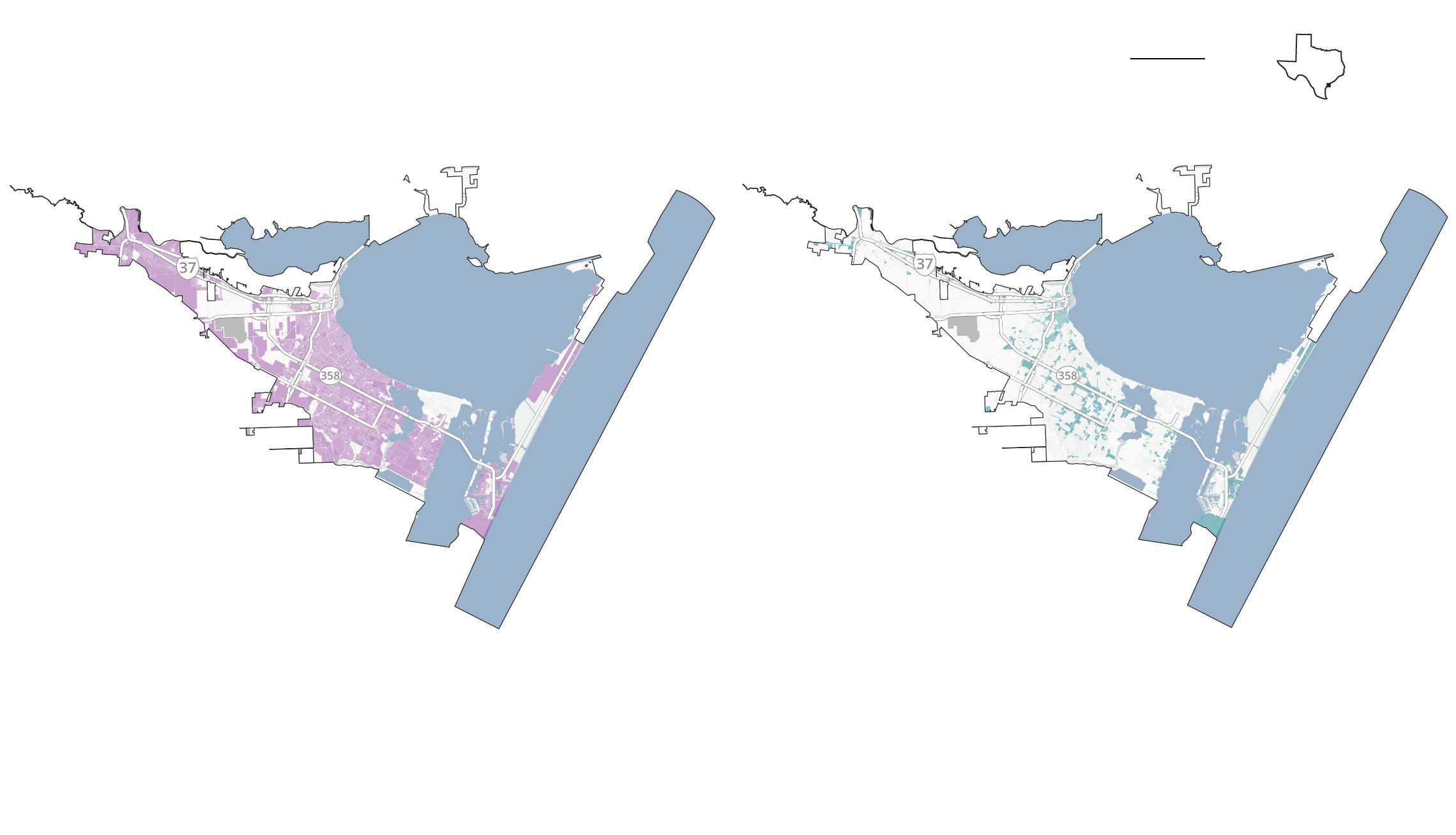
5 miles
Corpus Christi
SINGLE-FAMILY DETACHED HOUSING
OTHER KINDS OF HOUSING
CORPUS CHRISTI
BAY
CORPUS CHRISTI
BAY
99% of land that allows residential units
23% of land that allows residential units
Note: The Tribune’s analysis does not include planned unit development districts. Those areas account for about 1% of the land where the city can regulate zoning.
Source: Corpus Christi Planning Department
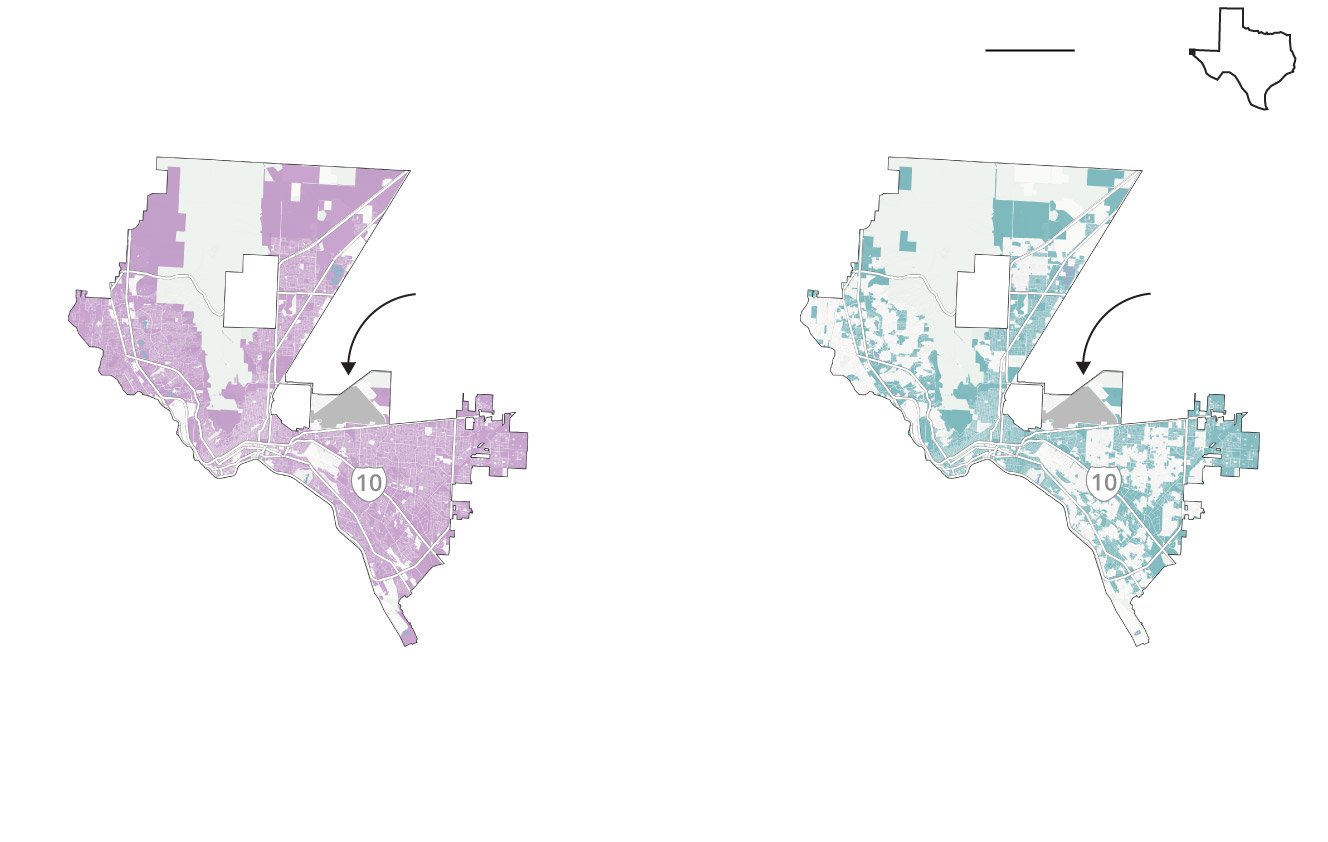
5 miles
El Paso
SINGLE-FAMILY DETACHED HOUSING
OTHER KINDS OF HOUSING
El Paso International Airport
El Paso International Airport
100% of land that allows residential units
56% of land that allows residential units
Source: El Paso Planning Department

El Paso
SINGLE-FAMILY DETACHED HOUSING
El Paso International Airport
5 miles
100% of land that allows residential units
OTHER KINDS OF HOUSING
El Paso International Airport
56% of land that allows residential units
Source: El Paso Planning Department

El Paso
5 miles
SINGLE-FAMILY DETACHED HOUSING
OTHER KINDS OF HOUSING
El Paso International Airport
El Paso International Airport
100% of land that allows residential units
56% of land that allows residential units
Source: El Paso Planning Department

5 miles
Fort Worth
SINGLE-FAMILY DETACHED HOUSING
OTHER KINDS OF HOUSING
100% of land that allows residential units
22% of land that allows residential units
Note: The Tribune’s analysis does not include planned development districts. Those areas account for about 14% of the land where the city can regulate zoning.
Source: Fort Worth Planning Division

Fort Worth
SINGLE-FAMILY DETACHED HOUSING
5 miles
100% of land that allows residential units
OTHER KINDS OF HOUSING
22% of land that allows residential units
Note: The Tribune’s analysis does not include planned development districts. Those areas account for about 14% of the land where the city can regulate zoning.
Source: Fort Worth Planning Division
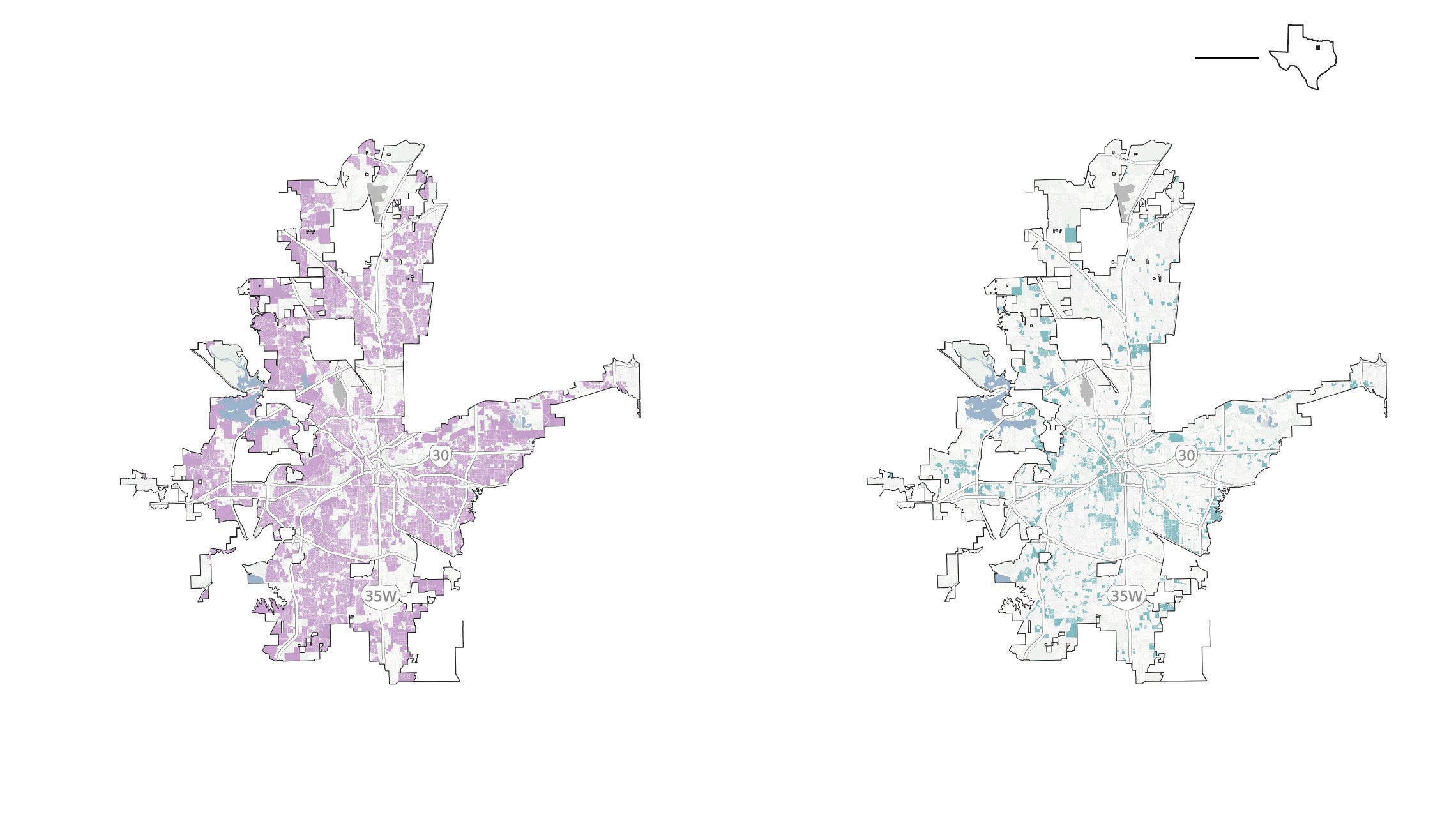
Fort Worth
5 miles
SINGLE-FAMILY DETACHED HOUSING
OTHER KINDS OF HOUSING
100% of land that allows residential units
22% of land that allows residential units
Note: The Tribune’s analysis does not include planned development districts. Those areas account for about 14% of the land where the city can regulate zoning.
Source: Fort Worth Planning Division
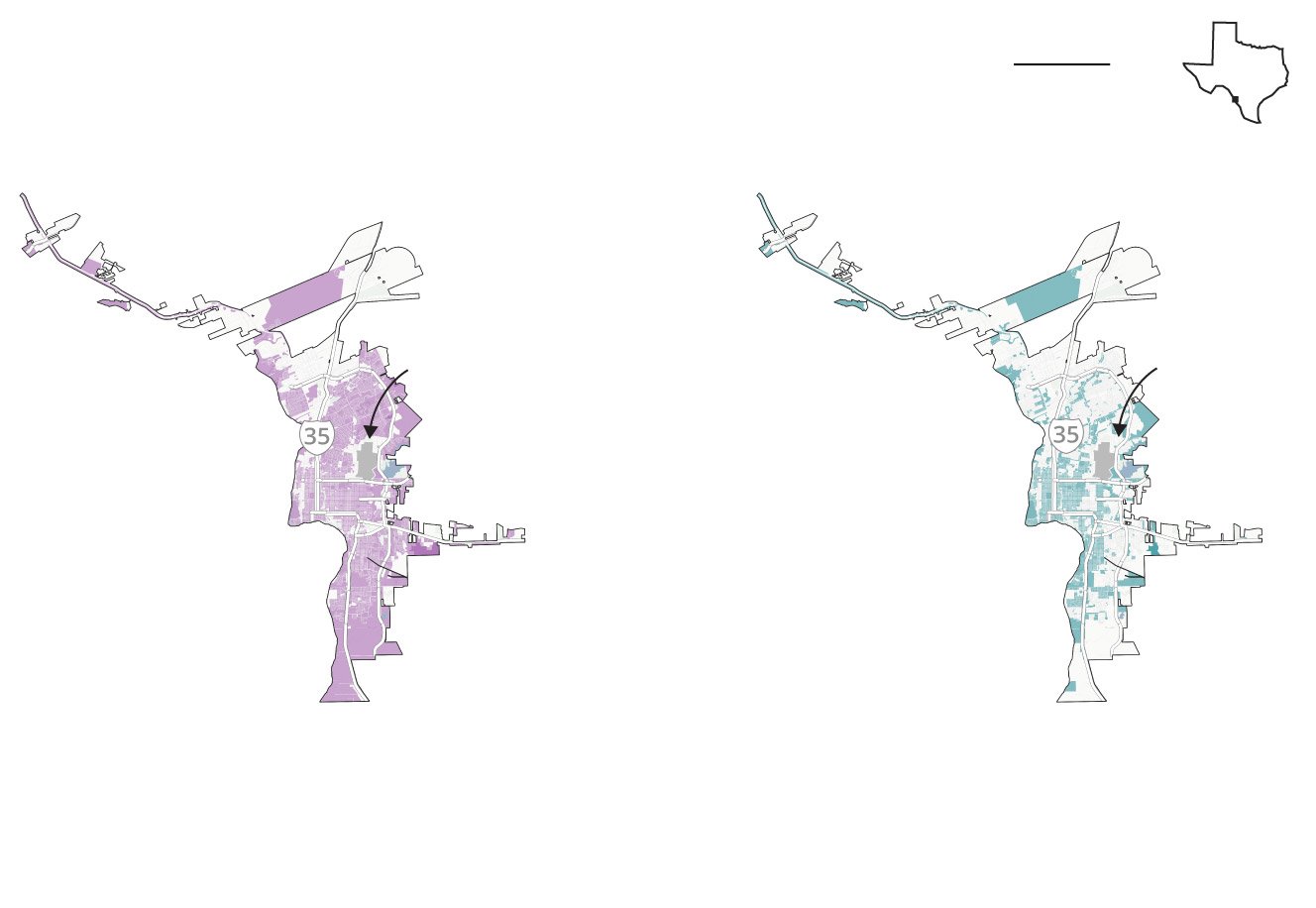
5 miles
Laredo
SINGLE-FAMILY DETACHED HOUSING
OTHER KINDS OF HOUSING
Laredo International Airport
Laredo International Airport
100% of land that allows residential units
50% of land that allows residential units
Source: Laredo Planning and Zoning Department

Laredo
SINGLE-FAMILY DETACHED HOUSING
Laredo International Airport
5 miles
100% of land that allows residential units
OTHER KINDS OF HOUSING
Laredo International Airport
50% of land that allows residential units
Source: Laredo Planning and Zoning Department

Laredo
5 miles
SINGLE-FAMILY DETACHED HOUSING
OTHER KINDS OF HOUSING
Laredo International Airport
Laredo International Airport
100% of land that allows residential units
50% of land that allows residential units
Source: Laredo Planning and Zoning Department

5 miles
Odessa
SINGLE-FAMILY DETACHED HOUSING
OTHER KINDS OF HOUSING
86% of land that allows residential units
47% of land that allows residential units
Note: The Tribune’s analysis does not include planned development districts. Those areas account for about 10% of the land where the city can regulate zoning.
Source: Odessa Planning Division
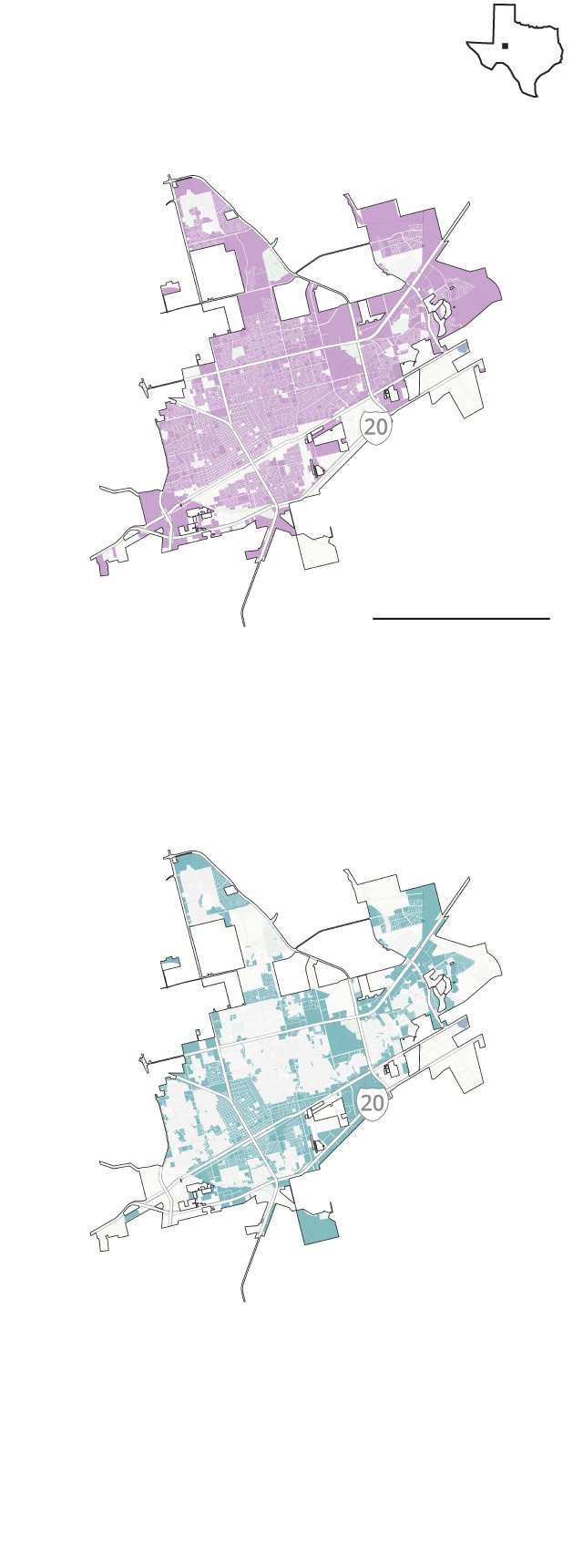
Odessa
SINGLE-FAMILY DETACHED HOUSING
5 miles
86% of land that allows residential units
OTHER KINDS OF HOUSING
47% of land that allows residential units
Note: The Tribune’s analysis does not include planned development districts. Those areas account for about 10% of the land where the city can regulate zoning.
Source: Odessa Planning Division

5 miles
Odessa
SINGLE-FAMILY DETACHED HOUSING
OTHER KINDS OF HOUSING
86% of land that allows residential units
47% of land that allows residential units
Note: The Tribune’s analysis does not include planned development districts. Those areas account for about 10% of the land where the city can regulate zoning.
Source: Odessa Planning Division
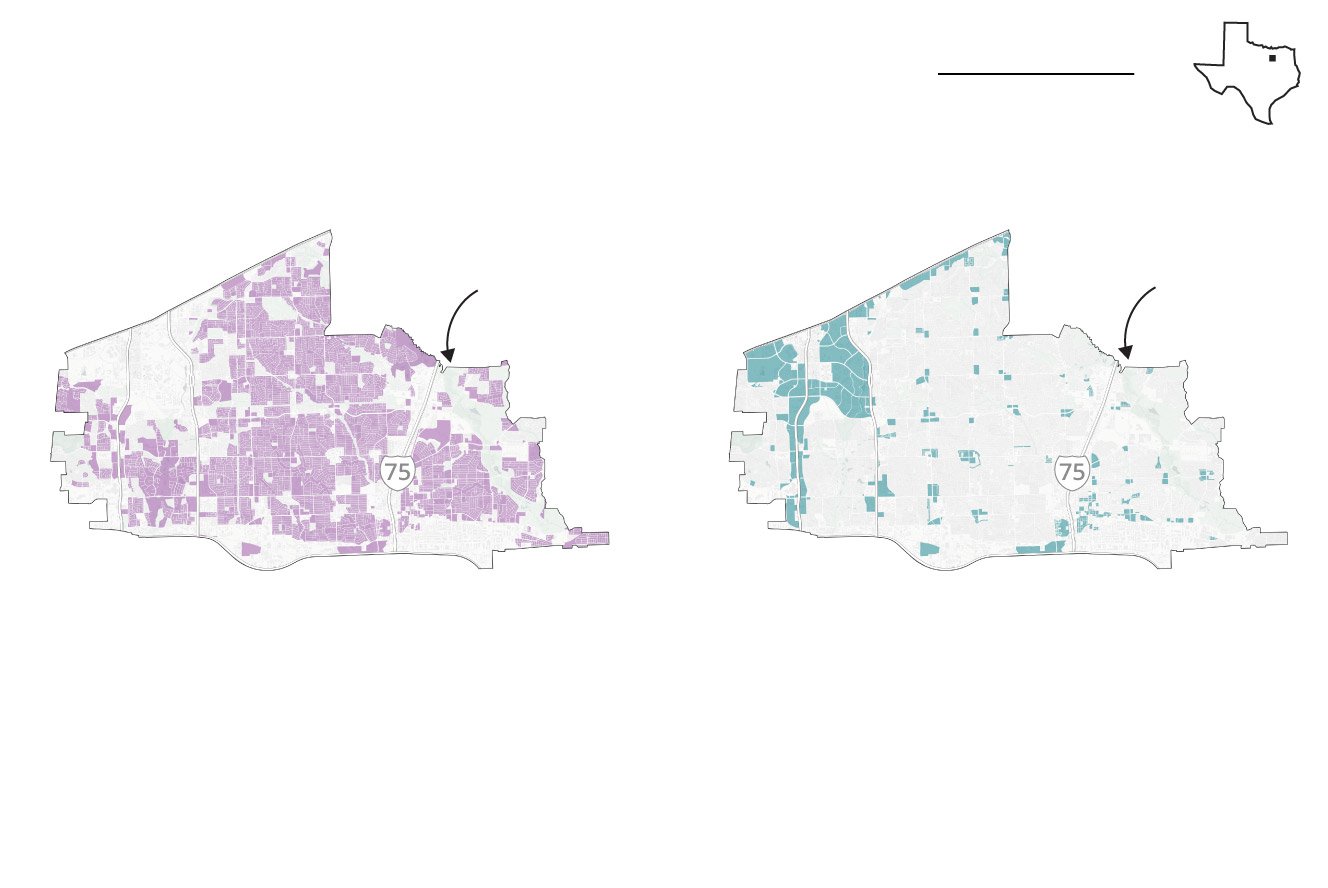
5 miles
Plano
SINGLE-FAMILY DETACHED HOUSING
OTHER KINDS OF HOUSING
Oak Point Park and Nature Preserve
Oak Point Park and Nature Preserve
86% of land that allows residential units
25% of land that allows residential units
Note: The Tribune’s analysis does not include planned development districts. Those areas account for about 25% of the land where the city can regulate zoning.
Source: Plano Planning Department
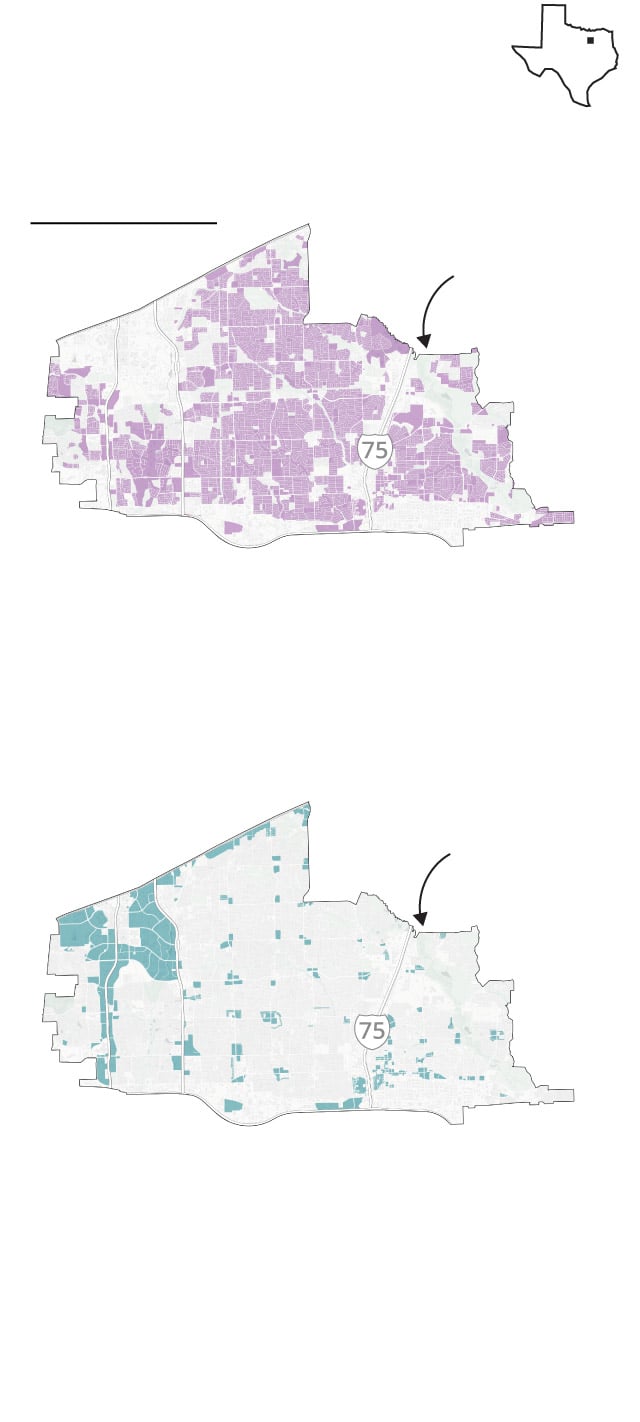
Plano
SINGLE-FAMILY DETACHED HOUSING
5 miles
Oak Point Park and Nature Preserve
86% of land that allows residential units
OTHER KINDS OF HOUSING
Oak Point Park and Nature Preserve
25% of land that allows residential units
Note: The Tribune’s analysis does not include planned development districts. Those areas account for about 25% of the land where the city can regulate zoning.
Source: Plano Planning Department
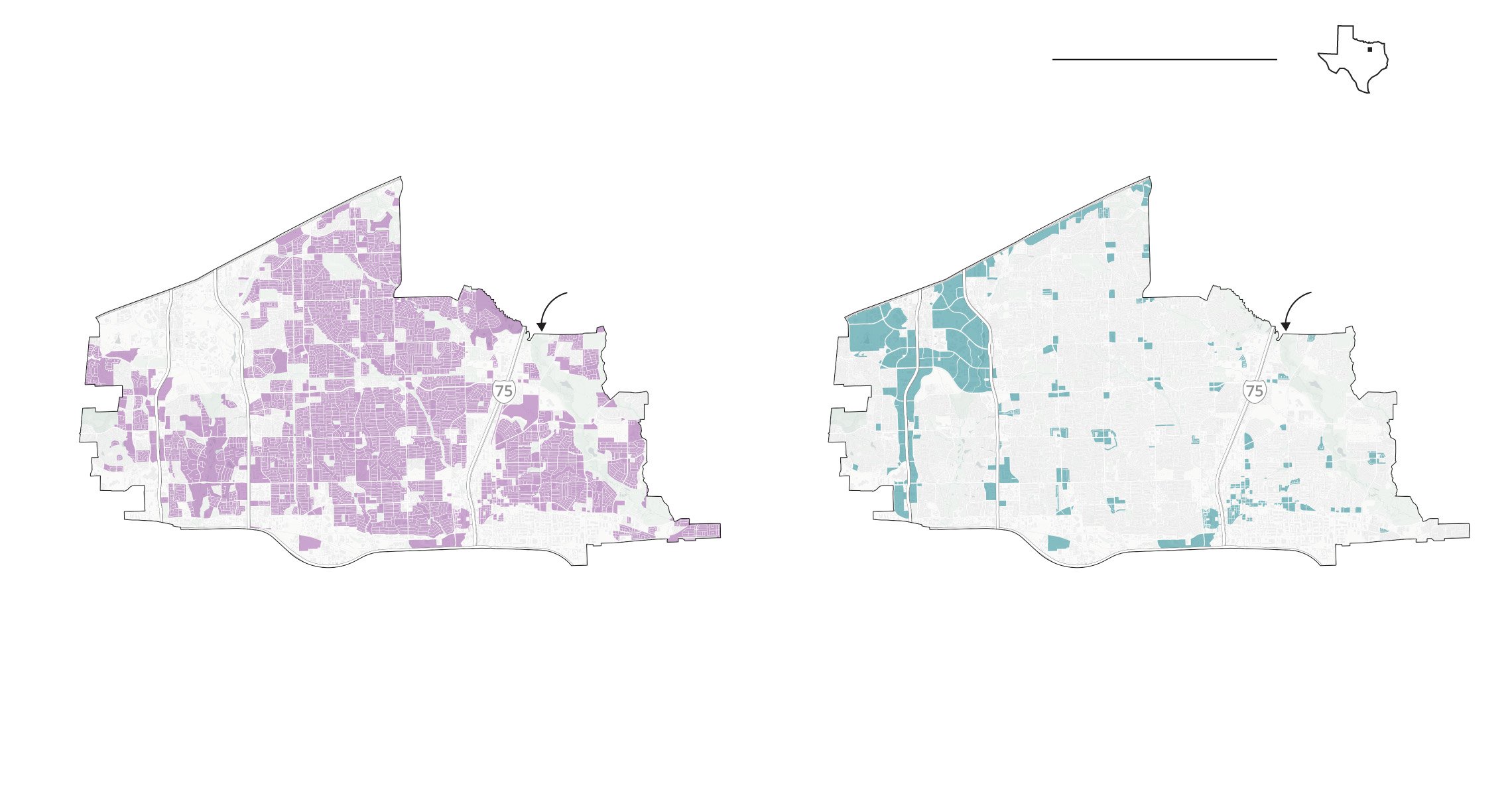
Plano
5 miles
SINGLE-FAMILY DETACHED HOUSING
OTHER KINDS OF HOUSING
Oak Point Park and Nature Preserve
Oak Point Park and Nature Preserve
86% of land that allows residential units
25% of land that allows residential units
Note: The Tribune’s analysis does not include planned development districts. Those areas account for about 25% of the land where the city can regulate zoning.
Source: Plano Planning Department
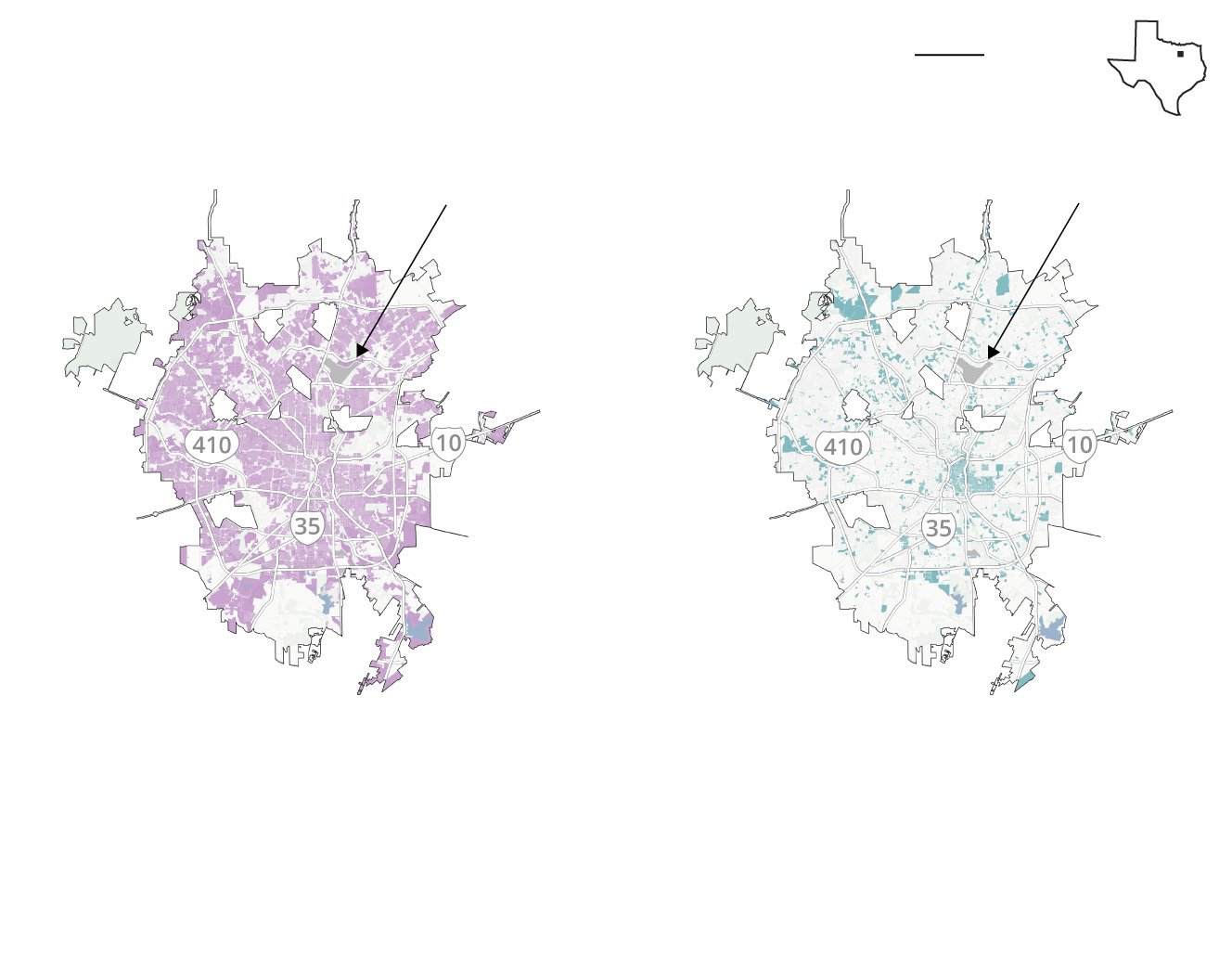
5 miles
San Antonio
SINGLE-FAMILY DETACHED HOUSING
OTHER KINDS OF HOUSING
San Antonio International Airport
San Antonio International Airport
100% of land that allows residential units
21% of land that allows residential units
Note: Planned unit development districts were removed from the analysis. They account for about 6% of the land where the city can regulate zoning.
Source: San Antonio Planning Department

San Antonio
SINGLE-FAMILY DETACHED HOUSING
San Antonio International Airport
5 miles
100% of land that allows residential units
OTHER KINDS OF HOUSING
San Antonio International Airport
21% of land that allows residential units
Note: Planned unit development districts were removed from the analysis. They account for about 6% of the land where the city can regulate zoning.
Source: San Antonio Planning Department

5 miles
San Antonio
SINGLE-FAMILY DETACHED HOUSING
OTHER KINDS OF HOUSING
San Antonio International Airport
San Antonio International Airport
100% of land that allows residential units
21% of land that allows residential units
Note: The Tribune’s analysis does not include planned unit development districts. Those areas account for about 6% of the land where the city can regulate zoning.
Source: San Antonio Planning Department
Out of the 162,610 acres that make up Dallas’ land mass where the city can regulate zoning, more than half allow some kind of residential development, the Tribune’s analysis shows. Detached single-family homes can be built on more than 96% of that land. But other kinds of homes like townhomes, duplexes, multiplexes and large apartment buildings can only go on about 17% of residential land.
Dallas also has more than 1,000 “planned development” districts, each with their own rules governing what kind of housing can be built. Those areas represent about 20% of the city’s total land.
“If so many pieces of the land have different rules, it leads to confusion,” said Andrea Gilles, Dallas’ deputy planning director. “You just never know what you're going to get, and it's hard to keep track of.”
A century of zoning rules
The origins of these rules go back almost a century ago when urban planners across the country argued they needed tools to handle rapid urbanization and problems like congestion, pollution and overcrowding.
Opposition and outright hostility to denser kinds of housing like duplexes and apartments was baked into the foundation of early zoning efforts. In an opinion upholding the state law that granted Texas cities the power to enact zoning ordinances, the Texas Supreme Court described apartments and tenement houses as “frequently radiating points for disease and focal points for immorality and crime.”
With those powers, city planners in major cities like Austin, Dallas, Fort Worth and San Antonio walled off large, exclusive swaths of land for single-family homes and separated them from where builders could legally put other kinds of housing.
Critics today say those rules are one of the reasons why Texas struggles to add homes at the same pace it adds residents and households.
In the years after the 2008 housing crash, construction of new homes stayed practically at the same levels as the previous decade — despite the state seeing nearly three times the job growth. Texas’ housing supply dramatically tightened and prices rose as a result.
“There's certainly tremendous demand for housing in Texas,” said Daniel Oney, research director at the Texas Real Estate Research Center at Texas A&M University. “It's been strong for a long time, and the supply has not been able to keep up with that.”
Residential real estate experts have long said: in a healthy housing market where buyers have about as much bargaining power as sellers, it would take all the current homebuyers six months to buy every home for sale. The last time Texas had that much inventory was in July 2012 when the median sales price of a home sat at about $223,000 in today’s dollars, according to A&M data. The market reached its lowest point in more than three decades in February 2022, when Texas had a little more than one month’s worth of supply. By then, the median sales price of a home in Texas was close to $361,000, a 62% increase from a decade before.
The state’s overall home price growth has since eased as high interest rates slowed the pace of homebuying and led to homes staying on the market for longer periods of time. But home prices remain well above where they sat prior to the COVID-19 pandemic.
How building more brings costs down
A growing body of research shows that building more homes drives down home prices and rents, and that places that have relaxed their zoning restrictions have kept their housing prices in check.
Minneapolis is a recent test case for zoning reform. City officials loosened their zoning rules in 2018, allowing duplexes and triplexes to be built in areas previously reserved for single-family homes. They also got rid of minimum parking requirements for new developments and encouraged apartments to be built along transit and commercial corridors.
Those reforms helped Minneapolis significantly ramp up its housing production from 2017 to 2022 and keep rents from rising as fast as they did in the rest of Minnesota, according to recent analysis by The Pew Charitable Trusts. However, this didn’t lead to a huge boost in homes like duplexes and triplexes. Larger apartment buildings made up the overwhelming majority of Minneapolis’ housing production in those years.
Perhaps the most prominent example of how zoning reform can boost home construction and tamp down overall housing costs happened in Texas.
More than two decades ago, Houston officials loosened rules on how much land a single-family home needs to sit on. Thousands of new homes have been built on smaller lots since then, which housing experts and advocates say helped keep a lid on the city’s home prices relative to other U.S. major cities like New York, Los Angeles and Chicago.
In the Austin region, development took off considerably in response to crushing demand during the pandemic. Apartment builders obtained an average of 22,000 construction permits a year from 2020 to 2023, nearly twice as much as in previous years. More than 20,000 units were under construction in the Austin area as of October, figures from the firm MRI ApartmentData show.
That injection of new supply forced rents down. Costs remain above pre-pandemic levels but have fallen for 16 straight months as more apartments become available.
“Because supply is outpacing demand, we do see downward pressure on rent,” said Laila Assanie, senior business economist at the Federal Reserve Bank of Dallas.
The same effects have also been felt in places like San Antonio, Nashville, Jacksonville and Phoenix, where rents either slowed or fell in recent years as they permitted more apartments.
However, it’s likely rent increases will return in the coming years as apartment builders scale back and demand for housing remains strong, economists project.
What does zoning reform look like?
Some Texas cities have begun to relax their zoning ordinances in a bid to allow more housing to be built.
After about a decade of local battles, the Austin City Council passed several reforms intended to boost the city’s housing supply in the last two years. One of them lets developers build up to three units in most places where detached single-family homes are allowed, though they must have a certain amount of land if they want to put more than one unit on the property.
Before the vote late last year, less than 40% of Austin’s residential land allowed homes other than standalone single-family homes. Now, about 64% of the city’s residential land does.
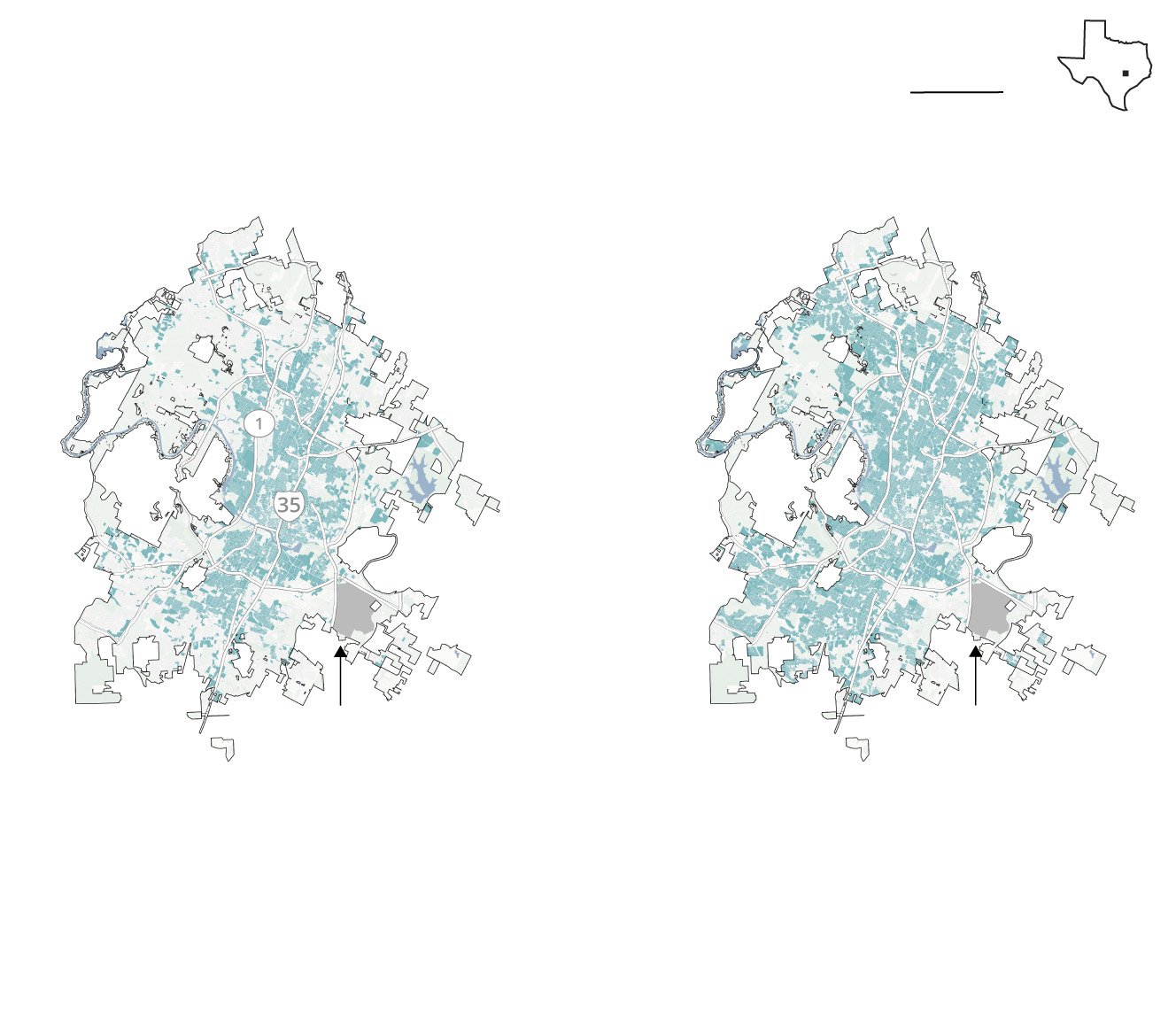
Austin
5 miles
OTHER KINDS OF HOUSING
Before zoning changes
After zoning changes
Austin-Bergstrom International Airport
Austin-Bergstrom International Airport
40% of land that allows residential units
64% of land that allows residential units
Note: The Tribune’s analysis does not include planned unit development districts. Those areas account for about 18% of the land where the city can regulate zoning. In addition, the new regulation changes only applied to SF-1 through SF-3 zoning categories to lots over 5,750 square feet.
Source: Austin Planning Department

Austin
OTHER KINDS OF HOUSING
Before zoning changes
5 miles
Austin-Bergstrom International Airport
40% of land that allows residential units
After zoning changes
Austin-Bergstrom International Airport
64% of land that allows residential units
Note: The Tribune’s analysis does not include planned unit development districts. Those areas account for about 18% of the land where the city can regulate zoning. In addition, the new regulation changes only applied to SF-1 through SF-3 zoning categories to lots over 5,750 square feet.
Source: Austin Planning Department

Austin
OTHER KINDS OF HOUSING
Before zoning changes
After zoning changes
5 miles
Austin-Bergstrom International Airport
Austin-Bergstrom International Airport
40% of land that allows residential units
64% of land that allows residential units
Note: The Tribune’s analysis does not include planned unit development districts. Those areas account for about 18% of the land where the city can regulate zoning. In addition, the new regulation changes only applied to SF-1 through SF-3 zoning categories to lots over 5,750 square feet.
Source: Austin Planning Department
Meanwhile, Lubbock effectively got rid of single-family zoning.
Until last year, only about 14% of the city’s residential land allowed housing units that weren’t detached single-family homes. But last October, the Lubbock City Council voted to loosen its zoning code to let developers build duplexes, triplexes and fourplexes in places that previously only allowed single-family homes.

Lubbock
5 miles
OTHER KINDS OF HOUSING
Before zoning changes
After zoning changes
Lubbock Preston Smith International Airport
Lubbock Preston Smith International Airport
14% of land that allows residential units
99% of land that allows residential units
Source: Lubbock Planning and Zoning Commission
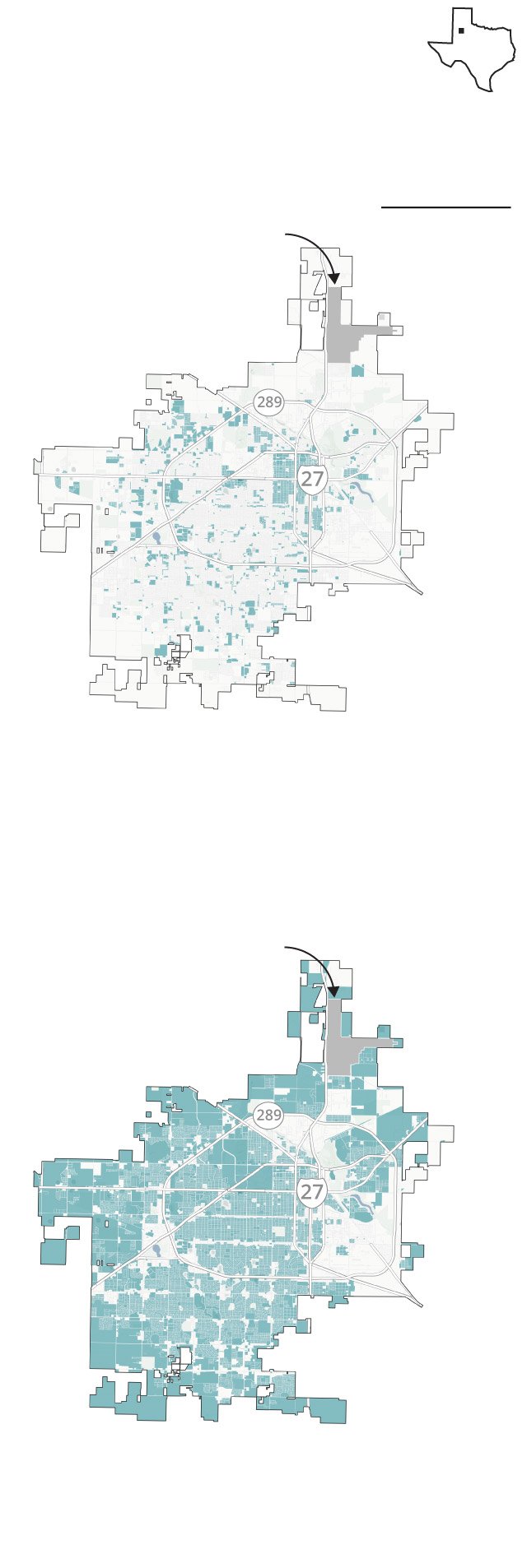
Lubbock
OTHER KINDS OF HOUSING
Before zoning changes
5 miles
Lubbock Preston Smith International Airport
14% of land that allows residential units
After zoning changes
Lubbock Preston Smith International Airport
99% of land that allows residential units
Source: Lubbock Planning and Zoning Commission

Lubbock
5 miles
OTHER KINDS OF HOUSING
Before zoning changes
After zoning changes
Lubbock Preston Smith International Airport
Lubbock Preston Smith International Airport
14% of land that allows residential units
99% of land that allows residential units
Source: Lubbock Planning and Zoning Commission
Changing the city's development code made sense given developers' growing interest in building denser options, said Kristen Sager, the city’s planning director.
“When it comes down to it, it’s housing. It's the same thing as a single-family home next to you, and it's for individuals who maybe can't afford to buy a home, or don't want to buy a home,” Sager said. “It's important to have those choices and that variety of housing for everyone.”
That doesn’t mean long-standing single-family neighborhoods will change overnight, Sager said. Lubbock still has rules that essentially limit duplexes, multiplexes and apartments from being built if they’re too close to single-family homes. Developers can still build new subdivisions that only allow detached single-family homes.
Fort Worth received $5 million from the U.S. Department of Housing and Urban Development to study, among other issues, whether the city needs to relax some of its residential zoning restrictions.
“We really wanted to see, ‘are there things that we need to add or take away to remove some of those (barriers) to housing,’” said Kacey Bess, director of the city’s Neighborhood Services Department.
The targets of zoning reform
Zoning reformers have zeroed in on a handful of policies they contend have exacerbated the nation’s housing affordability crisis.
Minimum lot-size requirements, or the rules that determine how much land single-family homes can be built on, are a big target.
If cities require larger lot sizes, builders will construct larger homes to make up for the cost of the land. That drives up the final cost for potential homebuyers in a market where the overwhelming majority of homes come with a front and backyard. Larger lot sizes also leave less land to build other homes, which translates to fewer homes being built across the board.
“If you have 10 acres with one-acre lots, you're gonna get 10 houses. If you have half-acre lots, you're gonna get 20. Quarter-acre lots, you get 40. So the smaller the lots, the more units per acre you can get built,” said Texas Association of Builders CEO Scott Norman.
And the smaller the lot, the lower the price of the home. Houston requires new homes to sit on at least 3,500 square feet of land, or 1,400 square feet if the land meets certain requirements. That’s low compared with other major cities, including in Texas. The value of townhouses built on lots previously reserved for larger homes was typically around $340,000 as of 2020 — about $200,000 below the value of the typical single-family home built around the same time, according to Furman Center research.
Houston is an outlier in allowing smaller lot sizes citywide. The most common minimum lot-size requirements among Texas’ other major cities fall between 5,000 and 7,500 square feet, the Tribune’s analysis found. But cities also have a range of lot-size requirements that vary depending on the area. For example, a detached single-family home in a neighborhood in southern Dallas may be required to sit on at least 5,000 square feet of land while the same type of housing in a North Dallas neighborhood may be required to sit on at least 10,000 square feet.
Policymakers have begun to rethink those rules. Earlier this year, the Austin City Council reversed an 80-year-old policy and reduced its minimum lot size requirements in much of the city from 5,750 square feet to 1,800.
Cities require homes to sit on a certain amount of land. Here’s how those requirements look across Texas.
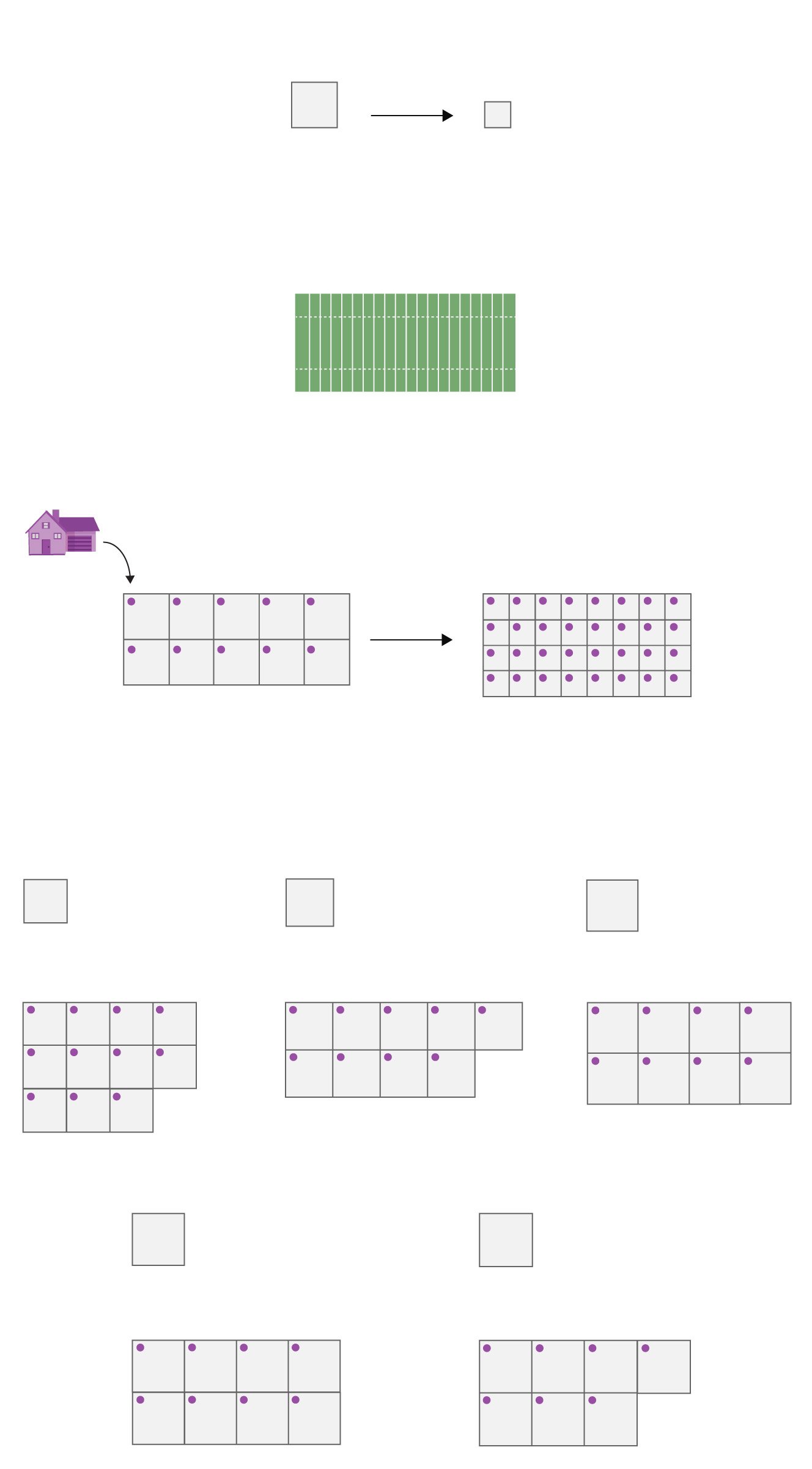
In 2024, Austin reduced its minimum lot size requirements for detached single family homes in much of the city.
NOW
BEFORE
1,800 sq. ft.
5,750 sq. ft.
Because the amount of land Austin requires to build such a home in those areas is now smaller, you can build more homes there. For reference, a football field is about 57,600 square feet.
That’s about 10 times the amount of land Austin required those homes to be built on in much of the city, meaning 10 homes could be built in that space. Under the new rules, 32 homes could be built there.
Austin
Austin
BEFORE
NOW
10 lots
32 lots
Other cities’ most common lot-size requirements are larger. As a result, homes take up more land and fewer of them can be built.
Corpus Christi, El Paso, Laredo, San Antonio
Lubbock, Fort Worth
Plano
5,000 sq. ft.
6,000 sq. ft.
7,000 sq. ft.
8 lots
11 lots fit in a football field
9 lots
Arlington
Dallas
7,200 sq. ft.
7,500 sq. ft.
7 lots
8 lots

In 2024, Austin reduced its minimum lot size requirements for detached single family homes in much of the city.
NOW
BEFORE
1,800 sq. ft.
5,750 sq. ft.
Because the amount of land Austin requires to build such a home in those areas is now smaller, you can build more homes there. For reference, a football field is about 57,600 square feet.
That’s about 10 times the amount of land Austin required those homes to be built on in much of the city, meaning 10 homes could be built in that space. Under the new rules, 32 homes could be built there.
BEFORE
Austin
10 lots
NOW
Austin
32 lots
In other cities, the most common minimum lot sizes are bigger, and you can fit less homes in a football field.
Lubbock, Fort Worth
5,000 sq. ft.
11 lots fit in a football field
Corpus Christi, El Paso, Laredo, San Antonio
6,000 sq. ft.
9 lots
Plano
7,000 sq. ft.
8 lots
Arlington
7,200 sq. ft.
8 lots
Dallas
7,500 sq. ft.
7 lots
Another target: rules that require housing developers to build a certain amount of on-site parking.
Those rules, critics argue, force developers to put in parking spots where they may have otherwise built housing and ultimately contribute to higher home prices and rents. Apartment landlords pass the cost of building and maintaining parking spaces on to tenants in the form of higher rents.
Last year, Austin became the largest city in the country to get rid of parking requirements citywide. Dallas could be next in line.
Policymakers and housing advocates have also embraced allowing accessory dwelling units — often referred to as ADUs, granny flats, mother-in-law suites or casitas — in the backyard of single-family homes as a relatively low-cost way of adding to the housing stock.
Odessa doesn’t allow ADUs in single-family neighborhoods but is considering whether to permit them in at least some areas, Odessa Deputy City Manager Agapito Bernal said. Allowing them, Bernal said, will hopefully trigger a chain reaction that frees up existing housing stock when new homes are built. For example, if an Odessa homeowner builds an ADU to house their mother, she will vacate the home where she previously lived, allowing another family to move into that property.
“We want to be able to create a different source of attainable housing,” Bernal said.
Other major cities surveyed by the Tribune technically allow ADUs but many have rules that discourage them. It’s common for cities to require that property owners who want to add an ADU reside in the main house. Cities also often require those units to be a certain size, sit on a certain amount of land and come with at least one parking spot. Texas lawmakers considered a bill last year that would’ve relaxed many of those restrictions but it failed in the Texas House.
El Paso officials likely won’t wait for state lawmakers to make those changes for them. The El Paso City Council is expected to vote later this year on a proposal to get rid of some of the city’s ADU restrictions.
“What we're trying to think about is the lowest hanging fruit from a housing production standpoint,” said Alex Hoffman, an assistant city planning director.
Another idea is to allow housing in commercial areas, which Corpus Christi, El Paso, Odessa and Plano allow, according to the Tribune’s analysis. The practice was blocked in Austin, but it’s appealing to zoning reform proponents and some Texas homeowners who don’t want other types of housing in their typically single-family neighborhoods. For both, the idea has the added benefit of getting rid of dying, unsightly strip malls.
Cities like Austin, San Antonio, Dallas and Fort Worth have also eyed ways to allow more housing along transit corridors.
Austin made changes this year to allow denser housing along the city’s planned light-rail route. Developers may build even taller apartment buildings there if they set aside a certain amount of units for lower-income households.
San Antonio officials are eying similar ways to promote denser housing along the city’s planned rapid bus line that runs from San Antonio International Airport through downtown to the city’s South Side.
Limits and skepticism
It’s still unclear whether the Texas Legislature will try to rein in housing costs when they convene in Austin next year. Last year, lawmakers considered proposals to relax city restrictions on ADUs, minimum lot sizes, how many units can go on a lot and how tall apartment buildings can be if they’re close to single-family homes. The Texas House, led by Democrats, rejected the ADUs proposal in a dramatic and chaotic House vote. The remaining bills never came up for a vote.
Lt. Gov. Dan Patrick and embattled House Speaker Dade Phelan have each signaled they’d like to see lawmakers tackle the state’s housing affordability crisis next year, including potential zoning tweaks.
Opponents of zoning reform tend to object to allowing more housing on a variety of grounds. Some don’t want more housing to be built near them because they worry it would change the character of their neighborhoods. Others worry the changes could bring down the value of their homes and cause them to lose equity. Homeowners in low-income neighborhoods of color worried about displacement, fearing changes could cause the opposite effect and raise their home values to the point they can no longer afford their property taxes.
Evidence of what happens to property values when a city allows denser housing in single-family neighborhoods is somewhat scarce. One study showed that sales prices of single-family homes in Minneapolis grew 3% to 5%, a modest increase, the year after officials allowed up to three homes on existing single-family lots citywide. Meanwhile, a study by the Mercatus Center, a free market think tank at George Mason University, found no evidence that Houston’s lot-size reform spurred higher land values.
Texas has mechanisms intended to prevent rapid increases in homeowners’ tax bills. The state and many local governments give tax breaks to people who own the property and use it as their main residence. Texas also limits how much those homes’ taxable value can increase in a given year. In addition, state law places stringent caps on how much local governments and school districts can collect each year in property taxes, a measure designed to limit how fast property owners’ tax bills can grow.
The dominance of single-family neighborhoods in Texas cities may in fact complicate local governments’ and school districts’ finances.
Cities, counties and school districts levy taxes to help pay for improvements, operations and other financial commitments. But single-family homes don’t generate as much tax revenue as denser housing types.
Dallas, for example, has a $16 billion backlog of needs, including upgrades to parks, existing roads, public safety facilities and flood and drainage infrastructure. But city budget writers only expect Dallas to collect about $1.1 billion in property taxes, one of its major revenue sources, to fund its current budget — an amount that must also be used to pay for police and fire protection, among other costs.
The city’s land-use patterns provide some insight into why that funding gap exists. Single-family detached homes make up about 35% of Dallas’ land use, Brita Andercheck, the city’s chief data officer, recently told city council members. But when measured by how much taxable value they produce per acre, single-family homes only account for about 4% of the city’s tax base.
Meanwhile, mixed-use developments — which often have a blend of residential units, restaurants, shops and office space — make up less than 1% of Dallas’ land but account for about 40% of the city’s total taxable value per acre, Andercheck said.
Cities can’t expect to provide reliable services and keep property tax bills low if they don’t allow denser housing to be built, said Joe Minicozzi, an urban planner who heads the firm Urban3, which analyzes how cities’ land use shapes public finances.
“Every American city is in this bind,” Minicozzi said. “Our attitude is, ‘just be honest with people.’”
Some critics of denser housing believe that if a new apartment building goes up somewhere, surrounding rents will increase, fueling displacement of lower-income residents of color. But new research shows multifamily housing might have the opposite effect.
Houston’s reforms to allow homes on smaller lots may have shielded lower-income communities from displacement, the Furman Center found. When townhouses replaced traditional single-family homes, they tended to do so in wealthier neighborhoods or in parts of town that had already gentrified.
Academics argue zoning regulations enshrined segregation in tandem with other practices like racial redlining, a 20th-century federal practice that made it more difficult for people to access housing loans in predominantly Black and Hispanic neighborhoods.
Restricting what kind of housing can be built and where has played a key role in shaping patterns of racial and economic segregation in the state’s major urban areas, according to a recent Harvard University report. Researchers found such rules can keep renters, who tend to be more racially diverse, out of single-family neighborhoods, which are overwhelmingly white and wealthy.
“It's really clear-cut,” said Magda Maaoui, a co-author of the Harvard report.
Some caution that relaxing cities’ land use rules will go only so far in promoting housing affordability — and that some hurdles will be tough to fix.
When Austin relaxed its zoning regulations on housing development this year, some warned that private deed restrictions, which supersede zoning rules, may still get in the way of the reforms because they may limit how many homes can go on a lot, regardless of what zoning rules now allow.
It’s unknown how much of Austin falls under deed restrictions. It’s possible that many of Austin’s neighborhoods, particularly whiter and wealthier ones, will effectively be exempt from the city’s recent reforms because of deed restrictions placed on them when they were first built, said Elizabeth Mueller, a professor of community and regional planning at the University of Texas at Austin. If so, new development will be rerouted onto poorer neighborhoods of color, which have already borne the brunt of the city’s growth and displacement problems.
“If we do these reforms, and a lot of areas are just off the table, then we increase the pressures on the areas that are … already [so] exposed, already under pressure under their current zoning,” Mueller said.
Zoning reform is a crucial step in solving the state’s housing affordability woes, housing advocates and experts argue, but it’s not a cure-all solution.
Texas has long had a dire shortage of homes that fall within the budget of the state’s poorest families, a shortage that only worsened as the state’s economy took off and its supply of cheap, low-rent apartments all but evaporated.
Loosening cities’ zoning rules by itself will not lead to more homes being affordable to lower-income households, said Ben Martin, research director for Texas Housers, a research and advocacy group. Texas spends little on housing for low-income families, he noted, and lawmakers should tap the state’s expected $21.2 billion surplus to boost that investment and build more homes for its poorest families.
“We have a larger share of the pie that’s struggling more than ever before with that gap between their income and housing costs,” Martin said. “It’s going to take a public intervention in order to address that.”
Even if cities relax their zoning rules, other factors like interest rates, the cost of building materials and the pool of available construction workers also determine whether housing ultimately gets built.
“There’s a lot that needs to all line up in order for us to get more housing,” Been said. “Land-use regulation reform is one piece of the puzzle.”
Many — if not most — of the housing options available to Texans will likely continue to be single-family homes for some time. Any reform will likely take years to take root and for its effects on housing costs to be felt. But officials increasingly are realizing they need to allow different types of housing if they want to give more of their residents a shot of owning their own home.
“We hear all of the time, ‘I can’t afford to buy a house in Dallas,’” Gilles said at a recent City Council committee hearing. “My concern is, ‘how are new people going to live and have homeownership opportunities?’”
About the zoning data
The Tribune reviewed the zoning codes for Arlington, Austin, Corpus Christi, Dallas, El Paso, Fort Worth, Laredo, Lubbock, Odessa, Plano and San Antonio in October 2024 for this analysis. The findings were shared with and reviewed by zoning officials in most cities. Laredo officials did not respond to requests for comment. The Tribune also consulted the National Zoning Atlas.
The Tribune combined city zoning data with parcel data to determine what kinds of homes cities allow to be built. Those parcels were classified into the following categories:
- Can a residential unit be built on the parcel?
- Does the parcel allow a detached single-family home to be built?
- Does the parcel allow other kinds of housing to be built (e.g. townhomes, duplexes, apartment buildings, etc.)?
A parcel can be in a zoning district that allows detached single-family homes as well as other housing types. For example, a parcel in Austin that allows a detached single-family home to be built there may also allow a duplex or triplex. The Tribune’s analysis would count that parcel towards both designations.
The Tribune’s analysis does not include parcels in planned development districts, which have their own tailor-made rules governing what kind of housing can be built, or any undevelopable land like bodies of water and state parks.
Disclosure: City of Austin, City of Plano, City of San Antonio, Texas A&M University, Texas Association of Builders and The University of Texas at Austin have been financial supporters of The Texas Tribune, a nonprofit, nonpartisan news organization that is funded in part by donations from members, foundations and corporate sponsors. Financial supporters play no role in the Tribune's journalism. Find a complete list of them here.